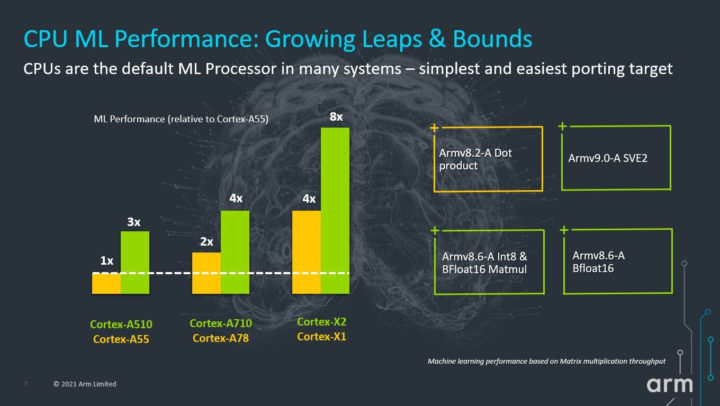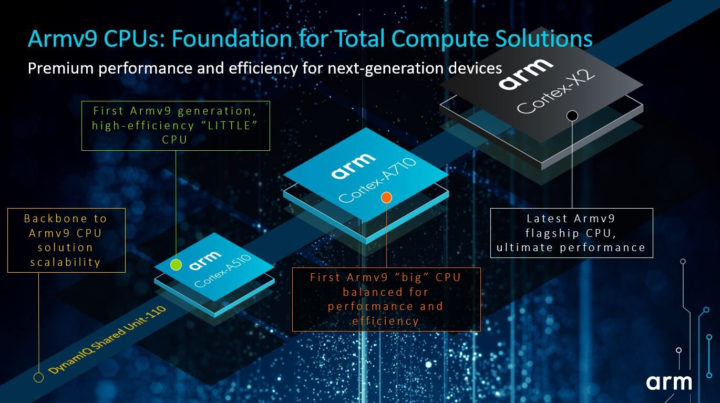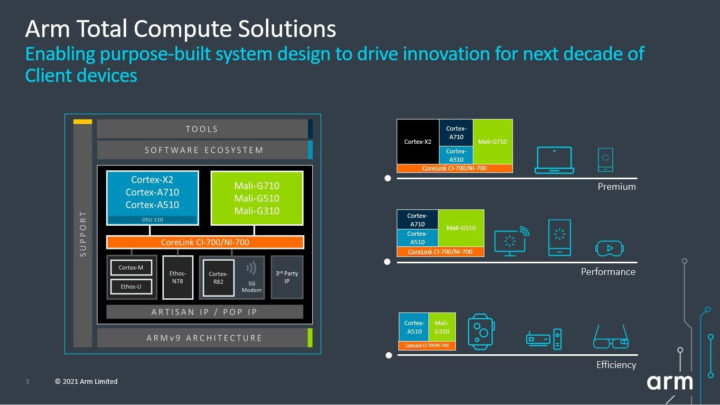Armv9 architecture was announced in Q1 2021, building upon Armv8 but adding blocks and instructions for artificial intelligence, security, and “specialized compute”, i.e. hardware accelerators or instructions optimized for specific tasks.
The company has now introduced the first three Armv9 cores with Cortex-X2, Cortex-A710, and Cortex-A510 cores, providing updates to respectively Cortex-X1, Cortex-A78, and Cortex-A55 cores. The company calls those new cores “Arm Total Compute solutions”.
Arm Cortex-X2 flagship core is the company’s most powerful CPU so far with 30% performance improvements over Cortex-X1 and will be found in premium smartphones and laptops. Arm Cortex-A710 “big” CPU core provides a 30% energy efficiency gain and 10% uplift in performance compared to Cortex-A78, while Arm Cortex-A510, high efficiency “LITTLE” Armv9 core delivers up to 35% performance improvements and over 3x uplift in ML performance compared to Cortex-A55 announced four years ago, or about the same performance as the “big” Cortex-A73 cores from just a few years ago. Cortex-A510 cores will be used in a broader range of devices from smartphones, to home appliances, and wearable devices.

Since we’ve just mentioned the “big” and “LITTLE” cores, Armv9 still supports DynamIQ technology where big and LITTLE cores work independently wiuth the same SoC. With Armv9 architecture this is handled by the new DynamIQ Shared Unit, DSU-110, supporting up to 8x Cortex-X2 CPUs. Arm also says all new mobile big & LITTLE cores will be 64-bit only in 2023 as previously announced in Arm Roadmap to 2022, but with one year delay. The company also added its global partners will ensure all apps will have 64-bit support by the end of this year to make the 64-bit only transition a seamless experience for consumers.
New Mali G-x10 GPUs and Interconnect for Armv9
Besides the new Armv9 cores, Arm also introduces four new GPUs:
- Arm Mali-G710 GPU with the highest performance designed for premium smartphones and Chromebooks. It is said to deliver 20% performance improvements for AAA high-fidelity games and a 35% machine learning uplift for tasks such as image enhancements compared to Mali-G78.
- Arm Mali-G610 is a “sub-premium GPU” with all the same features as Mali-G710 but at a lower price point. This is an update for Mali-G68 GPU
- Arm Mali-G510 mid-range GPU offers 100% performance improvements, 22% energy savings for longer battery life, and 100% ML uplift for mid-range smartphones, premium smart TVs, and set-top boxes compared to Arm Mali-G57. That means gaming performance should improve on mid-range devices for larger screens.
- Arm Mali-G310 entry-level GPU with the highest performance at the smallest area & cost. It will be found in entry-level smartphones, AR devices, and wearables.
In order to connect the Armv9 cores, new GPU, AI accelerator and other IP block, Arm also introduced two new interconnect with CoreLink CI-700 Coherent Interconnect and CoreLink NI-700 Network-on-Chip Interconnect. Both bring hardware-level support for new Armv9-A features such as Memory Tagging Extension (MTE), as well as improved bandwidth, lower latency, and increased security.
Armv9 SoC’s should be expected in consumer devices by next year. More details may be found on Arm’s CPU and GPU pages, as well as recent posts on Arm community’s processors blog.

Jean-Luc started CNX Software in 2010 as a part-time endeavor, before quitting his job as a software engineering manager, and starting to write daily news, and reviews full time later in 2011.
Support CNX Software! Donate via cryptocurrencies, become a Patron on Patreon, or purchase goods on Amazon or Aliexpress






